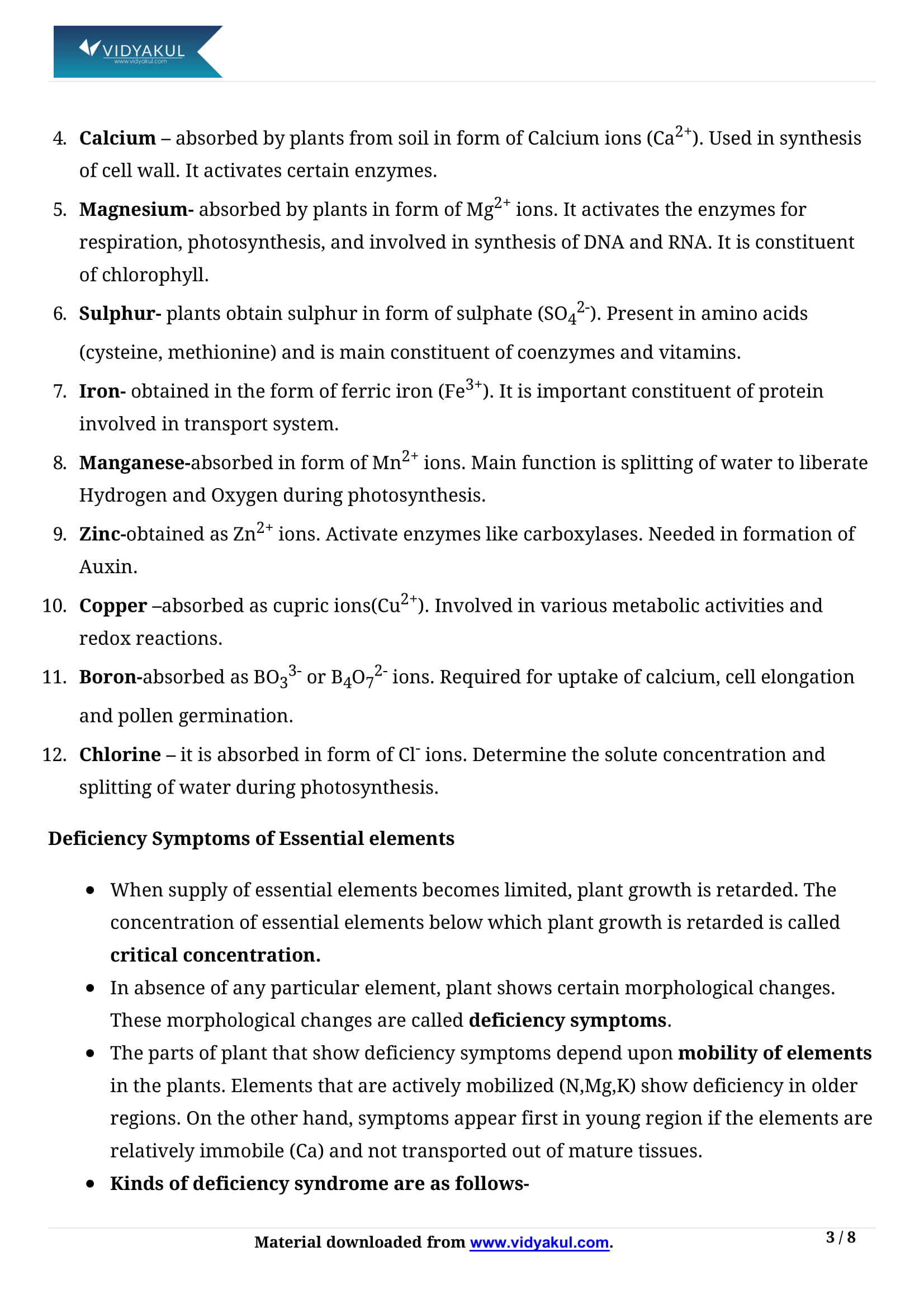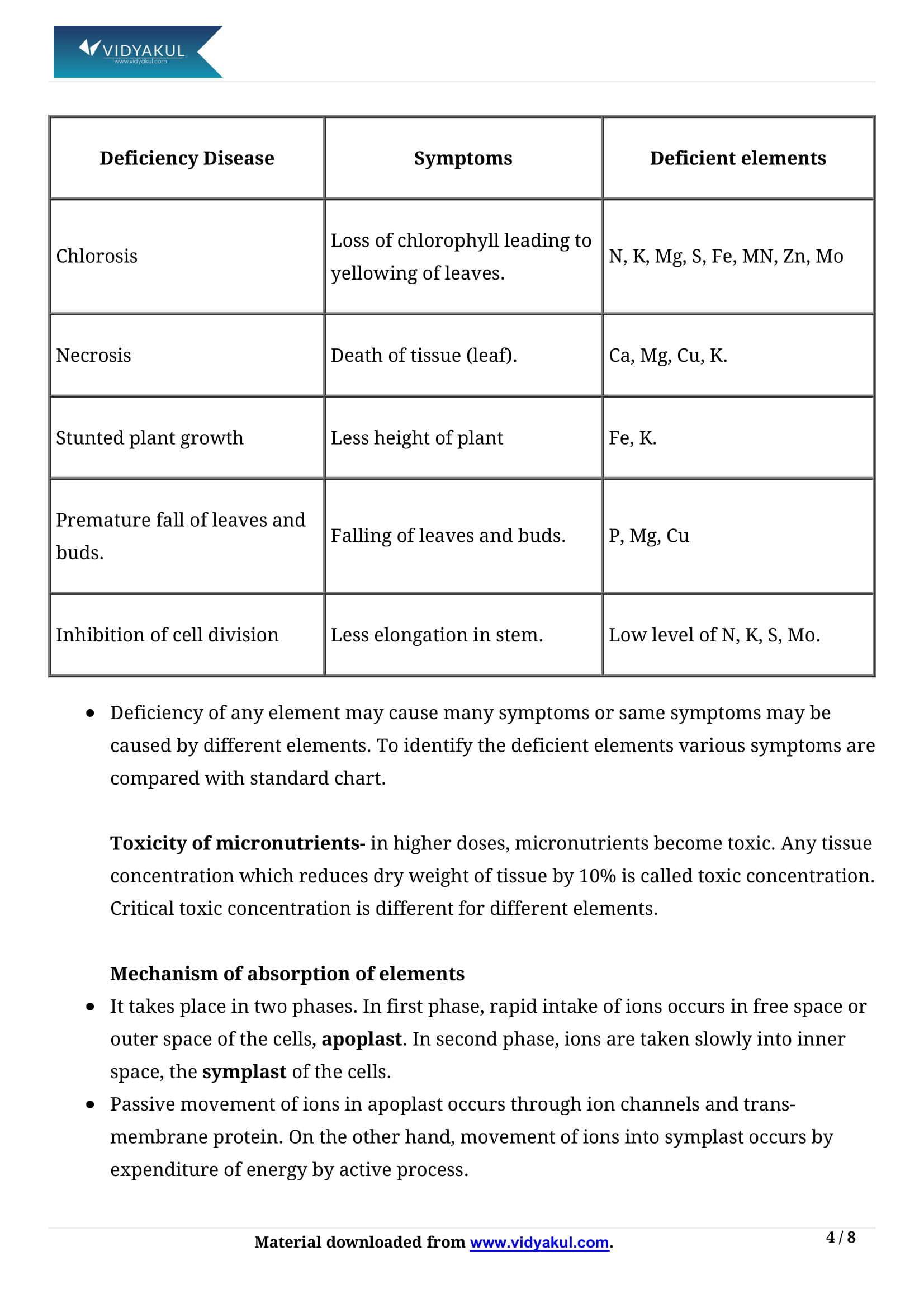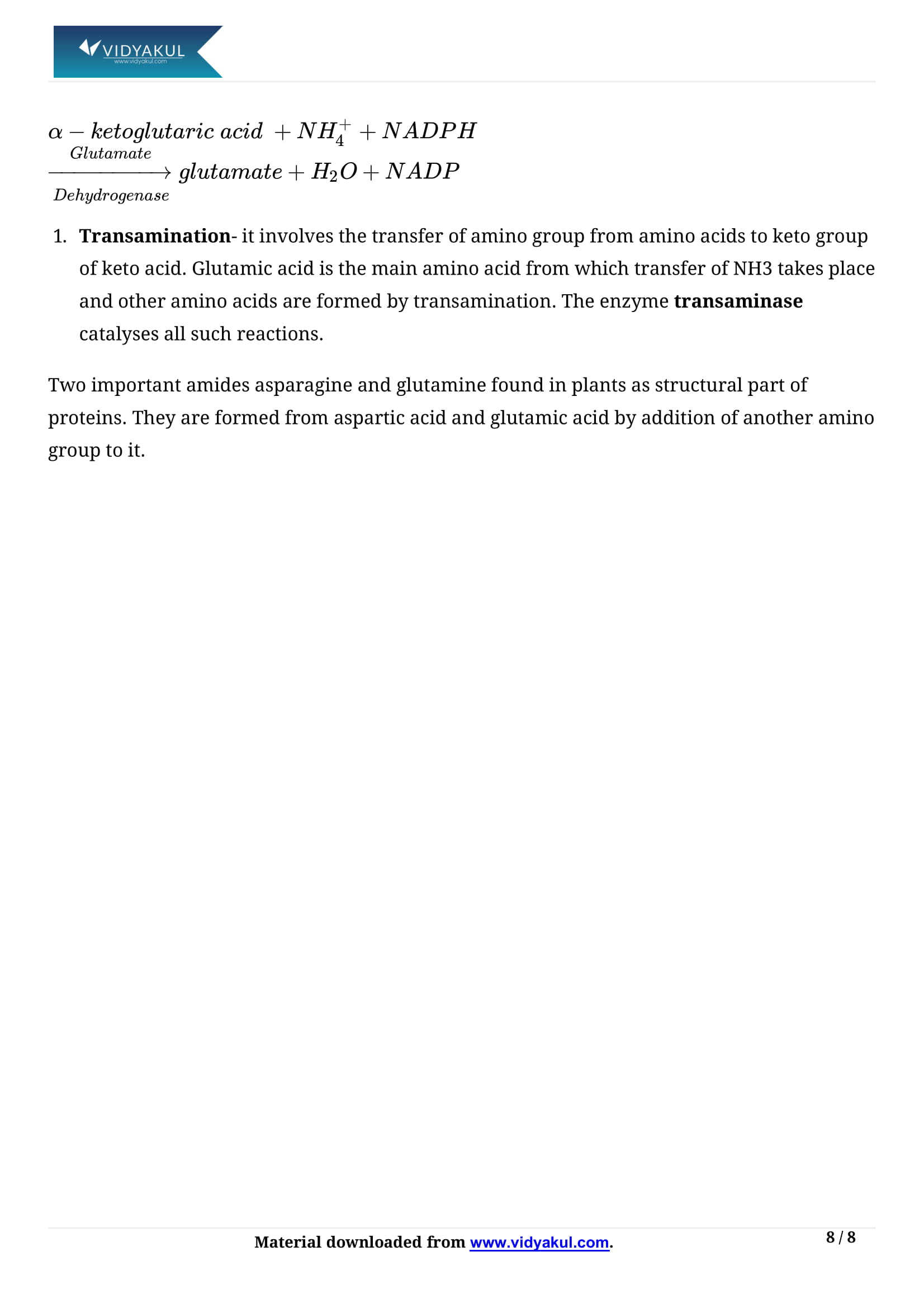Introduction to Mineral Nutrition Class 11 Notes

Chapter 12 Introduction to Mineral Nutrition
Chapter 12 of the CBSE Class 11 Biology and Mineral Nutrition course covers important topics useful in high school. Therefore, the NCERT notes for Year 11 Biology Chapter 12 is important for students. In this article, you will find all NCERT notes to the text questions and exercises in this chapter.
Class 11 Biology Chapter 12 notes are based on the latest updates. Also, these notes are accurate and easy to understand. It will also help you pass council exams and will be useful for competitive exams like NEET, AIIMS, etc. Students can practice over 200 questions provided on Vidyakul to understand the concepts.
CBSE CLASS 11 BIOLOGY CH-12
Points to Remember
Students can read the points mentioned below to summarize their topics for revision quickly.
Plants obtain their inorganic nutrients from the air, water, and soil.
17 elements are essential for plant growth and development.
Minerals are carried to all parts of the organism through the xylem and water transport.
Nitrogen is very essential for the sustenance of life.
Amino acids are the building blocks of proteins.
There are two types of biological nitrogen fixation – symbiotic and aposymbiotic.
Topics and Sub-topics
Experts at Vidyakul have provided NCERT notes for Class 11 Biology Chapter 12 and highlighted important topics below to help students learn and revise the concepts. Each topic has several questions for students to practise and gain an edge during the exams.
In addition, the practice questions help a student master the topic’s concept. Also, they can customise tests to assess their level and gain confidence to appear in the final exams.
Frequently Asked Questions
What are the essential elements for plants? State criteria for their essentiality. Give the classification of minerals basis the amount in which they are required by plants.
An element is said to be essential to a plant if it is required for maintaining its normal growth and reproduction. This requirement needs to be specified and cannot be replaced by any other element in the soil and should be directly involved in plant metabolism. Following are the criteria for essentiality:
A plant completes its life cycle in the deficiency of the element and is incapable to grow normally.
The element cannot be substituted by another element and is specific.
The element is important in plant metabolism.
Essential elements are further subdivided into:
Macro elements – Required by plants in larger quantities, they are H, O, N, Mg, Ca and S.
Microelements – They are referred to as trace elements and are needed in low quantities, they are Zn, Cu, Mo, Cl, and Fe
What will it be beneficial to plants if they are supplied with excess nutrients? If no, why and if yes, how?
No, it is not beneficial as higher doses of micronutrients may become toxic. Toxic concentration is any concentration that reduces the dry weight of tissue by 10%. However, critical concentration differs for various micronutrients and different plants. For instance, beyond 600μ is toxic for soybean and beyond 5300μ for sunflowers. These toxic effects can be either due to interference in the absorption and functioning of nutrients or due to the excess of the micronutrient. Example – Toxicity in manganese can be due to:
A decrease in the uptake of iron and magnesium.
Hindrance of calcium translocation into shoot apex.
Hindrance of binding of magnesium to specific enzymes.
Most of the crops are still cultivated on land despite hydroponics being a successful technique to grow plants. Why?
Hydroponics is a solution culture that is utilized to raise plants in a soilless medium. However, there are various disadvantages of these techniques, such as:
Regular root aeration for the normal growth of plants is required.
For maximum growth, the solution needs to be replaced frequently.
Undesirable pH changes due to the loss of certain ions that are quickly absorbed.
It is an expensive technique. The handling and settling of this technique need much more investment than soil-based production.
There are chances of these methods spreading water-borne diseases.
Due to the lack of knowledge, it is not practised by traditional farmers.
What are the essential elements? Explain macro and microelements with examples?
Roots are the underground part of all vascular plants and are mainly responsible for absorbing the chemicals present in their surrounding soil. Among all the available elements only 14 of the absorbed elements are necessary for plant growth and these are called as the essential elements. The essential elements are required in larger amounts and are called macronutrients. The essential elements required in lesser amounts are the micronutrients.
Macronutrients are absorbed from both the air and soil. It includes calcium, carbon, hydrogen, magnesium, nitrogen, oxygen, potassium, phosphorus, and sulfur.
Macronutrients are absorbed from the soil. It includes iron, boron, chlorine, manganese, zinc, copper, molybdenum, and nickel.
What is the importance of sulphur in plants? Name the amino acids which contain it.
It is an important macronutrient in plants which is absorbed by plants as an ion. It primarily functions as a component of proteins, vitamins(thiamine, biotin), coenzyme-A, amino acids (methionine, cysteine), etc. Also, it is a necessary component of ally sulphide (garlic, onion) and sinigrin(mustard). Sulphur deficiency can cause chlorosis in young leaves, the formation of hard and woody stems, extensive root growth, etc. It also results in a reduction of the juice content of citrus fruits and yellow disease of tea. Sulphur is found in amino acids methionine, cysteine, etc.
Practice Questions
Name an insectivorous angiosperm.
Give the biochemical events occurring in the root nodule of a pulse plant. What is the end product? What is its fate?
Mycorrhiza is a mutualistic association. How do the organisms involved in this association gain from each other?
For reductive amination, write the following equation.
Why does an excess of Mn in soil lead to a deficiency of Ca, Mg, and Fe?
Plants obtain their inorganic nutrients from the air, water, and soil.
17 elements are essential for plant growth and development.
Minerals are carried to all parts of the organism through the xylem and water transport.
Nitrogen is very essential for the sustenance of life.
Amino acids are the building blocks of proteins.
There are two types of biological nitrogen fixation – symbiotic and aposymbiotic.
What are the essential elements for plants? State criteria for their essentiality. Give the classification of minerals basis the amount in which they are required by plants.
A plant completes its life cycle in the deficiency of the element and is incapable to grow normally.
The element cannot be substituted by another element and is specific.
The element is important in plant metabolism.
Macro elements – Required by plants in larger quantities, they are H, O, N, Mg, Ca and S.
Microelements – They are referred to as trace elements and are needed in low quantities, they are Zn, Cu, Mo, Cl, and Fe
What will it be beneficial to plants if they are supplied with excess nutrients? If no, why and if yes, how?
A decrease in the uptake of iron and magnesium.
Hindrance of calcium translocation into shoot apex.
Hindrance of binding of magnesium to specific enzymes.
Most of the crops are still cultivated on land despite hydroponics being a successful technique to grow plants. Why?
Regular root aeration for the normal growth of plants is required.
For maximum growth, the solution needs to be replaced frequently.
Undesirable pH changes due to the loss of certain ions that are quickly absorbed.
It is an expensive technique. The handling and settling of this technique need much more investment than soil-based production.
There are chances of these methods spreading water-borne diseases.
Due to the lack of knowledge, it is not practised by traditional farmers.
What is the importance of sulphur in plants? Name the amino acids which contain it.
Name an insectivorous angiosperm.
Give the biochemical events occurring in the root nodule of a pulse plant. What is the end product? What is its fate?
Mycorrhiza is a mutualistic association. How do the organisms involved in this association gain from each other?
For reductive amination, write the following equation.
Why does an excess of Mn in soil lead to a deficiency of Ca, Mg, and Fe?
Know more about the same in Introduction to Mineral Nutrition Class 11 Notes pdf.
Download this solution for FREE Download this PDF
Download Vidyakul App for more videos, PDF's and Free video lectures.











